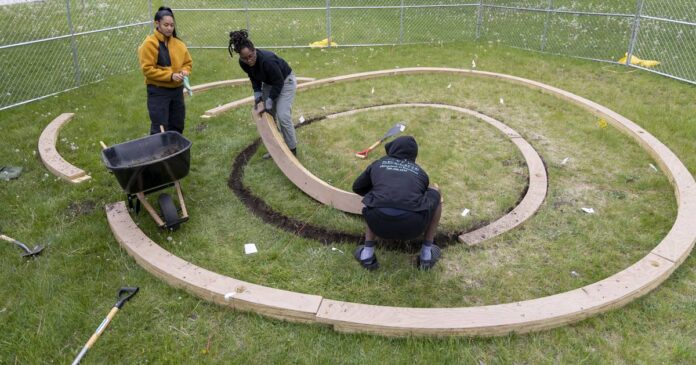In December 2021, Chicago artists and community organizations were called on to raise awareness of the city’s key environmental issues to nurture urgency and hope, and inspire action across neighborhoods. The results of that callout will be revealed in a launch of public art projects across Chicagoland under the banner E(art)H Chicago, or Earth Art Chicago, from June 3 to 17.
The Illinois Science and Energy Innovation Foundation gave out $679,500 in grants to artists and community organizations to produce projects that stimulate community engagement on environmental justice from the Southeast Side industrial corridor to the North Branch of the Chicago River. The work ranges from theater for toddlers inspired by the ecology of Chicago’s Southeast Side wetlands and pollinator columns in the Back of the Yards that function as a habitat for insects and animals, to a dance ritual in Grant Park that pays homage to the cultural traditions of the urban farm.
“We’re funding 12 exhibits in different neighborhoods and they all represent a variety of environmental issues … an issue that speaks to the community and is coming from the community,” said the foundation’s program director, Uzma Noormohamed. “We have environmental justice represented there, ecological grief, the relationship between the industrial development along the Chicago River and nature, and how to heal our relationship to the land, how to do things differently, how to have more native plants, how to look and think about our role differently, so it evokes a lot of different expressions.”
The foundation sought letters of interest from artists, environmentalists and nonprofits to apply for tiered grants ranging from $7,500 to $100,000 from December 2021 to January 2022. Nearly 150 applications were submitted, and 30 finalists from 19 neighborhoods were then interviewed by project staff members and art advisers who then selected 12 winners. Projects are located on the Southeast Side and in McKinley Park, Albany Park and Little Village, among other neighborhoods. Funding partners that include the Builders Initiative, the Joyce Foundation, Chicago Frontlines Funding Initiative and the Regeneration Fund provided money that went to artists, collaborative groups and nonprofit organizations.
Ines Sommer used a $35,000 grant to complete her 35- to 40-minute documentary film, “The Hills.” The work centers on a deserted 67-acre hill made up of slag that Republic Steel/LTV Steel dumped from the 1950s to 1980s and features voices of community members alongside contaminated land, water and wildlife. The Rogers Park filmmaker said she hopes viewers realize that the problems on one side of the city should matter to all Chicagoans. The film will be screened June 8 and 17.
:quality(70)/cloudfront-us-east-1.images.arcpublishing.com/tronc/QRNPVW33B5AABP3HVV7JM4XUJE.JPG)
“Not to sound catastrophic, but we can’t pretend like what’s affecting one part of our city will not have repercussions for all of us as Chicagoans,” Sommer said. “I think that’s the kind of level of awareness that I would love for people who live outside of the Southeast Side to have — that it should matter to all of us.”
Artists Alexx Temeña and Andrea Yarbrough partnered to bring the “House of Kapwa” to fruition by Oakwood Beach. The $90,000 interactive outdoor installation centers on rest, collective care, ecological grief and the Filipino Indigenous virtue ethic of Kapwa, or shared interconnectedness.
The large circular structure has an opening at the top that represents a connection to ancestors and to the divine when we rest and slow down. The structure’s exterior is a 360-degree natural loom that visitors can weave composted flowers and plant material into, and allows one to sense the relationship between how we care for ourselves, for one another and for Earth.
Temeña said it was important for the structure to be in a contemplative, relatively quiet space to honor the sacredness the pair were trying to imbue into the project, “a place that is going to be holding folks in a collective practice of rest and of collective grief.”
Yarbrough, steward of the group titled in c/o: Black women (in care of Black women), said space also had to be one that “someone who looks like us would go access.”
“When we rest, we start to feel … we grow a sense of awareness and concern and responsibility outside of ourselves, beyond ourselves and not just human to human but also human and land,” Temeña said. “It’s not just self and other, it’s self and plant, and self and planet. It’s this connection, and growing a sense of who we are is beyond our individual earthly bodies. In our rest, we connect to the cosmic nature of Kapwa and being able to extend that awareness and responsibility and concern. We are aware of the grief and the losses that we’ve endured collectively, that’s beyond just our particular individual losses.”
:quality(70)/cloudfront-us-east-1.images.arcpublishing.com/tronc/UVWF25BTSFHS7DD2FSPFW77SOM.JPG)
During the June 3 opening ceremony for “House of Kapwa,” Temeña will conduct a rest ceremony, with music and weaving as a way to contemplate ecological grief, as a meditative and contemplative practice. More events focused on collective wellness are set for the fall, Yarbrough said.
Noormohamed said artists coming together in this initiative have the opportunity to connect with their communities and create what essentially becomes a gathering space so people can organically learn and demand together, grieve together and act together.
“Art has always played that role in social change and transforming how we see things and how we understand and act in our world,” Noormohamed said. “We’re not saying go out and protest a certain issue or demand a certain policy. But we do know that this kind of coming together creates motion, it creates demand, demand creates pressure, creates change. That is one of our fundamental ideas that we have thought about, as far as how does this translate into something beyond this? When art is created intentionally to encourage community gathering, then people come together and they feel possibility.”
Visit earthartchicago.org for June ceremonies and screenings. Registration is required for some events.



